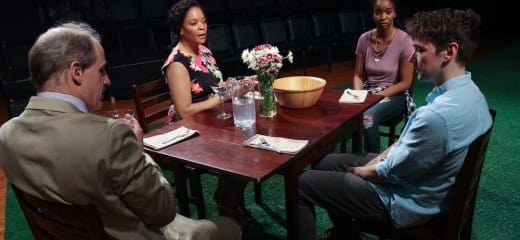In a quest to reach new audiences for performing arts in Philadelphia, Theatre Philadelphia and thINKingDANCE are joining forces and exploring how dance writing and discourse can provide new perspectives on theatre. Beginning May 2018, tD writers have been lending their varied backgrounds, interests, and approaches to criticism to professional works of theatre in Philadelphia. Let us know what you think in the comments!
I don’t know if I would call Sing the Body Electric, a new work by Michael Hollinger performed by Theatre Exile, a love story. Though the program notes “love, sex, and the unseen forces that draw us together and drive us apart” as central themes of the play, ultimately it was less a story of how one overcomes mistakes and traumas, and more about how one falls back into destructive coping mechanisms. Love and sex were merely the means.
This pattern was clearest in the daughter character, Jess, played by Kishia Nixon. She and her mother, Doris (Kimberly Fairbanks) are fresh transplants to Florida from Philadelphia after her parents’ splitting up, and she is a classic surly teenager: uninterested in school, talks back to her mother, sneaks out of the house in the middle of dinner. Her body language is floppy, apathetic, and her tone often comes across as defensive, as if she is clearly right and everyone else is only seeing the bad in her. Jess confuses me; she toes the line between self-absorption to the point of recklessness and the television/film archetype of a Manic Pixie Dream Girl.
At times, I am unsure if I am supposed to be reading her pursuit of Blake, the young silent-type, as romantic and special—i.e. “she’s the only one that gets him”—or simply dangerous. Her brash come-ons involve cajoling Blake, who survived a lightning strike, to share details about this traumatic evening that killed his girlfriend, and even to insist that his ongoing issues can be resolved by reliving the trauma to prove he can survive. Trevor William Fayle’s Blake pads lightly around the stage with the timidity of a bunny; his gestures are soft, yet quick. When Jess finally convinces Blake to show her his scars from that night and make out with her during a swirling thunderstorm on the same golf course where the original event occurred, I find myself cringing at the thought of Blake’s internal experience at that moment (indeed, we never find out what that was). Yet, I’m unclear whether I was supposed to read that pivotal moment as deeply irresponsible towards the young man’s state of mind or as a grand romantic gesture.
If Jess’s purpose in the plot is more than bringing healing or destruction to Blake, if she is more than a Manic Pixie Dream Girl, what is her motivation? To simply get the guy? I wonder if we would have understood Jess and Blake’s relationship post-golf course if that had been the central journey of her development. Instead, in our final image of her she is standing in her bedroom, looking in a mirror, admiring a new tattoo in the design of Blake’s lightning tattoos on her upper back. Perhaps this was her goal all along—to have a dramatic experience, to “feel alive”—though there is little in the plot to set this up for the character.
If we assume that Jess grapples with her impulsivity over the course of the play and ultimately emerges unchanged, each of the characters follows a similar arc. Doris, Jess’s “mental health counselor” mother, is revealed to be a professional fraud; Blake doesn’t ever overcome the traumas of his past; his father, Lloyd, continues to explode as his “anger issues” originating with the abandonment of his wife go unresolved; Claire, a member of Doris’s therapy circle and Blake’s fellow patient, is seduced again and again by the promise of a savior in romantic love.
While it may be rare for lightning to strike twice, the characters’ lack of self-study in Sing the Body Electric doom them to second shocks.
To join the conversation, follow thINKingDANCE and Theatre Philadelphia online and on social media to read, share, and comment.
Sing the Body Electric, Theatre Exile, Latvian Society, April 19 – May 13





